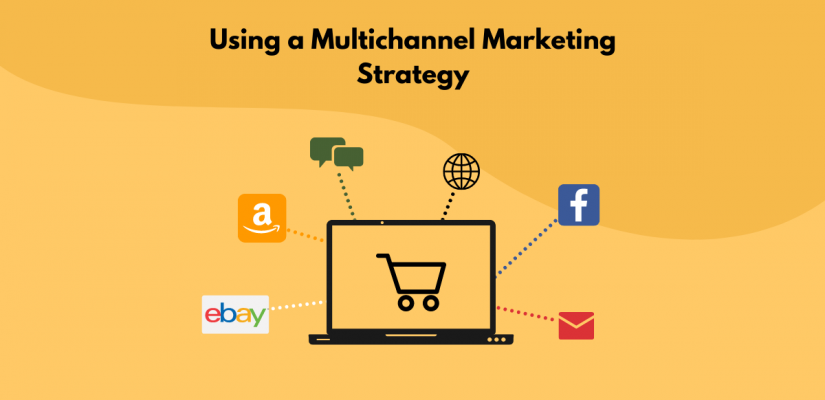
Using a Multichannel Marketing Strategy
Using marketplaces and different networks for a multichannel strategy can significantly help your eCommerce store, especially during big events, such as BFCM and the holiday season. These tactics involve listing your products on many different sales channels in order to reach a large audience.
We’ll discuss some of the main steps to undertaking a multichannel strategy that can help you convert more customers into paying customers.
1. Diversifying your sales channels
By selling on multiple sales channels, you are rapidly increasing the number of people who can access your product. If you create your product listings correctly, there’s no reason why you can’t use multiple channels and marketplaces to advertise your products.
It’s a wise strategy to start with a select few channels instead of listing everywhere at once, as you’ll pay less in sellers fees. We reckon 2-4 networks is a good starting point.

2. Leverage high traffic levels
When using a marketplace, you’ll be able to tap into existing traffic from other websites in addition to your own web traffic. It’s a lot harder to generate traffic on your own.
As an example, Takealot is an alternative to Amazon in South Africa and has an average of 12 million visits monthly.
It’s highly unlikely that a new eCommerce store will have stats like this, especially just after launch. Existing marketplaces have had years to distinguish themselves as world-class eCommerce stores, so it would be silly to not leverage from their power over the online market.
3. Gain new customers
We’ve already mentioned that marketplaces have tons of visitors per month. These customers trust marketplace platforms for a number of reasons, and therefore, marketplaces yield higher conversion rates.
In short, there’s already a lot of traffic and trust owing to past purchases on large platforms or marketplaces. Selling on a marketplace allows you to tap into an existing loyal customer base – even if they’ve never heard of your brand before.

4. Take a chance on selling globally
Some online channels and marketplaces in particular, are extremely useful for selling across borders without having to do any translation work on your website.
You might not be an instant best-seller in any foreign country, but you can benefit from increased visibility – and you can now compete with many eCommerce sites around the world.
You might find that you have a lot of popularity in a region that you’d never considered accessible before. It’s possible to sell in Amazon in Europe or the US without being an American store, however, you may need to sort out some admin to get this done.
5. Marketplaces are growing
Projections for customer sales from marketplaces are set to exceed over $7 trillion by 2024. This means that if you’re not willing to sign up to marketplaces, you could be missing out on large amount of potential customers. The reason that marketplaces are so popular is that they’re trustworthy, efficient and have a large selection of products at many price points.
6. Ease of access
One benefit to joining a large marketplace as a seller is that it’s relatively easy and straightforward to get started. Some marketplaces will take care of shipping, hosting and all financial transactions – which can save you a lot of time and money. Depending on where you choose to list your products, you may not need to invest in developing a complex eCommerce website.
However, some channels will work better with an existing website, such as Facebook, Instagram, Bing, Google and PriceCheck.
7. Minimal Risk in going Multichannel
If you find you aren’t selling as well as you anticipated, the only cost you have incurred from using a marketplace is the seller fee, which is dependent on sales or clicks, depending on where you’re live.
This is a small price to pay in exchange for the prospect of earning higher profits. You can always adjust your listings on different platforms relative to their performance.

8. Access to insights and analytics
Marketplaces or networks can be great places to learn more about your business. Often, you have access to data about your sales volumes and other metrics such as demographics.
You may also be able to find out more about clicks and customer reviews. This data can be used to improve your product and understand more of your customers’ experiences.
9. Many Multichannel Options
Some popular locations you might consider listing your products on include ShareASale, Gumtree, Takealot, Pricecheck, Google, Facebook, Leroy Merlin and Bing.
Remember to research the appropriate marketplace for your category of products to find out if any niche markets are available.
10. Set up Automation
Using an all-in-one solution like ShoppingFeeder can help you list easily on many different channels.
ShoppingFeeder can help you manage your products on multiple marketplaces and networks. We make it easy for you to publish any changes across many channels, and we’ll save you time and money by automating this process for you.
Check out ShoppingFeeder for a free trial today.
Conclusion
In conclusion, it’s abundantly clear that there are many benefits to adopting a multichannel approach by listing on different places.
Remember that joining a marketplace doesn’t mean that you’ll need to abandon your ecommerce store. However, using a marketplace can help you easily boost your sales and gain regular customers that might not have found you otherwise.
It’s good practice to research all of possible marketplaces before commiting to one, even if it’s just for an initial trial period.
* Edited version of original article by Ash Frank.
